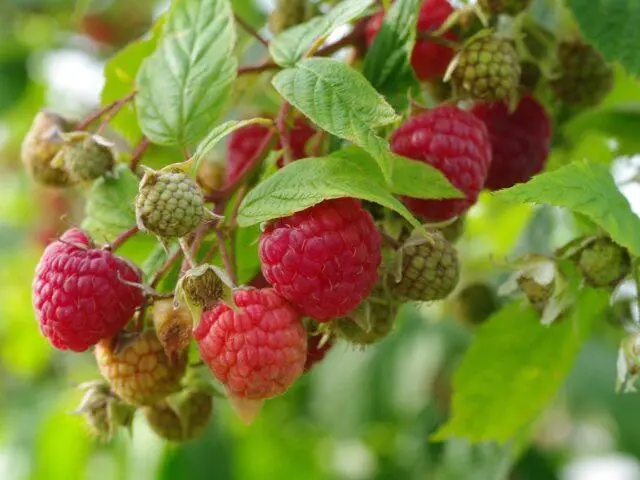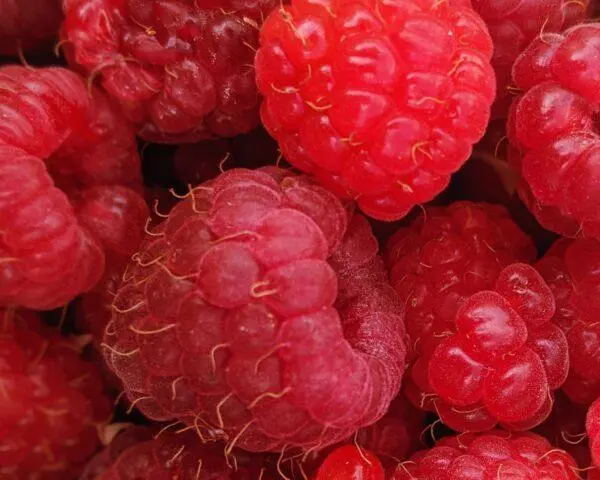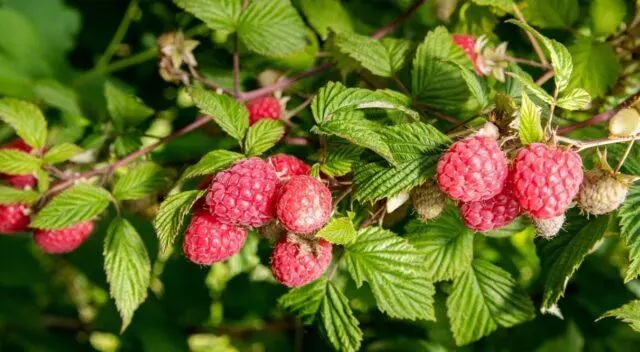Contents
Raspberry Coral – a late variety with a friendly ripening of fragrant medium-sized berries. A frost-resistant plant winters without loss in a cold climate, is not afraid of a sharp change in temperature at the beginning of the season. Suitable for growing on an industrial scale and in small summer cottages or household plots. The variety got its name because of the bright color of the berries.
The story of
Raspberry Coral was bred on the basis of the Leningrad POS by cross-pollination of Pavlovskaya with hybrid forms Novosti Kuzmina and English. Originator – Medvedeva O. A. In 1971, an application for varietal compliance was accepted. After successful experimental cultivation in 1979, it was included in the State Register with a recommendation for the North-West region.
Description of raspberry varieties Coral
The standard variety outwardly differs little from other representatives of the culture (except for hybrid forms). The stress resistance of the plant allows you to collect a stable crop, regardless of weather conditions.
Fruit
The berries of the Coral raspberry are formed on the shoots of the past and current season. The variety is self-fertile, each flower gives a full-fledged viable ovary.
What do fruits look like?
- the form is obtuse;

- unbalanced mass – from 2,5 g to 5 g;
- drupes are large, the arrangement is dense;
- the surface is bright crimson with a glossy sheen;
- the pulp is tender, juicy, fragrant.

Ripe berries do not crumble, but after five days they lose their elasticity and presentation
Bush
The raspberry bush Coral is tall, formed by 5-7 shoots, the length of which is 1,6-1,8 m. The stems are erect in the central part, the lateral ones are prone to lodging. The shape of the raspberry bush is medium spreading, the crown is densely leafy. Old stems are dark brown, woody, young ones are light purple in color, with drooping tops.
The leaves of the raspberry Coral are complex, tripartite, alternate, with carved edges, light green, with a corrugated surface.
The flowers are five-petalled, white, collected in racemose inflorescences.
Root system of mixed type, branched.

Thorns are short, not numerous, located at the bottom of two-year-old shoots.
Characteristics of raspberries Coral
This is a common crop variety with standard agricultural practices, bred for industrial cultivation in cold climates. Feels comfortable Coral variety in the Leningrad, Vologda region, Moscow region. Drought resistance is weak, it develops worse in a warm climate zone. Requires constant watering.
Ripening time and yield of raspberry Coral
The variety reaches its peak fruiting in the third year of growth. The berries ripen together within 10 days. The main collection is at the end of July. Raspberry Coral refers to late varieties. From one bush they collect 2,5-3 kg, about 70-75 centners per hectare.
Taste
Dessert variety, with a predominance of sugars. Acid is present in small quantities, mainly felt in berries that have not received sufficient heat and light. The aroma is pronounced. Coral raspberries are used fresh, juice is made, it is suitable for processing into jam, jam, marmalade, jelly. Tasting score 4,7 points out of 5 possible.
Frost resistance
An adult plant does not respond to temperatures down to -300 C, for heat-loving raspberries, this is a record figure. Young seedlings are less stable, they are recommended to cover the root system in the first two years of growth. Raspberry Coral has an early onset of sap flow, but the plant is quite winter-hardy, the variety is not afraid of spring frosts. In case of damage to the aerial part, it quickly forms a replacement, fruiting on the shoots of the current year, from a negative factor, does not decrease, the berries ripen on time.
Resistance to diseases
Subject to the agricultural technology of raspberry Coral, pathogenic microorganisms (fungi, bacteria, viruses) do not pose a threat. The plant is not afraid of the main diseases of the culture: all types of spotting, anthracnose, septoria.

In the cold rainy season, berries may be affected by gray rot.
Pros and cons of the variety
Benefits of Raspberry Coral:
- stress resistance;
- not afraid of low temperatures;
- the ability to form a replacement and a large number of root shoots for reproduction;
- berries are not prone to shedding, separation is dry;
- strong immunity;
- pronounced aroma and balanced taste;
- universality.
The disadvantages include the need to tie up the stems and the inability to transport the crop over long distances.
Features of growing raspberries Coral
In one place, the culture bears fruit within 12 years, then the bushes are transplanted. Therefore, the site is immediately taken away taking into account biological requirements: sunny, protected from the wind, located on the south or southeast side. The composition of the soil is fertile, light, with a neutral reaction.
Planting Coral Raspberries
The ability to calmly endure frosts allows you to determine the plant for a permanent place in the fall. The optimal time is from early to mid-September. Raspberry Coral has a high winter hardiness, planting is possible in the spring in the third decade of April.
How to do it right:
- They dig a hole or trench (if the placement is linear) 40 * 50 cm, depth – 45 cm.
- The sod layer is mixed with humus, superphosphate, nitrophoska, wood ash are added. Fill the bottom with a layer of 15 cm.
- The side shoots are cut off from the seedling. Leave only one 20 cm long.
- Raspberries are placed in the center of the hole, covered with soil.
- Pull the twine and tie it up.

The variety does not tolerate dense planting; in a tape arrangement, the distance between seedlings is 80 cm, row spacing is 2 m
Caring for Coral Raspberries
The bush is tall, so that the berries do not touch the surface of the soil, fixation to the support is necessary. Basically, the agricultural technology of the variety is standard:
- In the first year of the growing season, throughout the season, the soil near the plant is loosened and weeds are removed. Subsequently, mulch with compost or humus (layer up to 6 cm).
- Raspberries have an average drought resistance, so 5-6 liters of water per linear meter are watered 30-40 times per season. In rainy summers, additional soil moisture is not needed. In autumn, water-charging irrigation is carried out (40 liters under 1 bush).
- Raspberries are fed in early June with Lignohumate, you can replace it with any liquid organic matter. In the first days of July, “Agricola for berry crops” is introduced. After harvesting the fruits, Coral is fertilized with potassium and superphosphate.
In the spring, the tops of two-year-old raspberry stems are shortened by 15 cm, weak and dry areas are removed. In autumn, only one-year-old shoots (6-8 pieces) are left, the old ones are completely cut out.
Prevention of diseases and pests
To eliminate the risk of infection of the plant and the spread of parasitic insects, Coral raspberries are treated for preventive purposes with the following means:
- during the period of swelling of the kidneys, the bush and soil of the root circle are sprayed with Topaz;
- to enhance immunity during budding, raspberries are treated with Energen, and Iskra DE is used from pests;
- three weeks before the berries ripen, colloidal sulfur is used;
- during loosening, wood ash is added to the soil.
Conclusion
Raspberry Coral is a common crop variety bred for cultivation in temperate continental climates. It was created with the condition of cultivation and harvesting mechanized over a large area. Suitable for home gardens. The plant is winter-hardy, tall, with stable fruiting.









